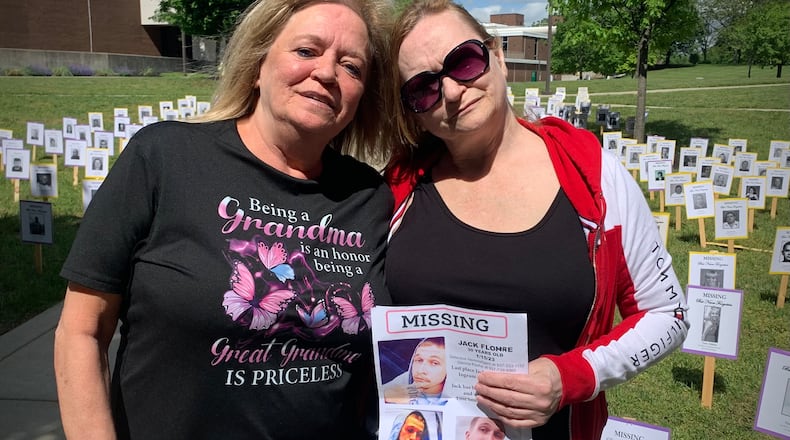Jack’s case is one of 25,604 open missing persons cases in the U.S, including about 429 in Ohio, according to the National Missing and Unidentified Persons System.
Despite significant advancements in law enforcement’s ability to locate missing adults and children, systemic issues are keeping the Flohre family and friends from knowing what happened to Jack, they said.
On Jan. 15, 2023, Jack left his mother’s East Dayton home with a woman who gave him a ride to West Dayton. Dayton police detectives obtained video footage from a security camera of Jack talking to someone on his cellphone as he walked along Ingram Street in West Dayton, near McCabe and Mallory parks.
Efforts by the family to retrieve Jack’s phone records have been frustratingly unsuccessful, Glenna said.
“That phone conversation, we would find out all the information we need to know, who he’s talking to, where he was going, why he was going, all of it. And they told us his phone was dead, so they couldn’t do anything,” she said. “They said that the phone records would go against the guy he’s talking to on the phone, his civil rights…What about my son’s civil rights?”
Phone records and conversations are protected under the Fourth Amendment of the Constitution, which protects Americans from unreasonable searches and seizures. A search warrant allows law enforcement to access those phone records, but if police have no evidence a crime was committed, that limits law enforcement’s ability to do certain things, said Paul Pijanowski, superintendent of the Ohio Bureau of Criminal Investigation.
“When a person goes missing, if we can’t prove a crime, a judge is not going to issue a search warrant. So that’s been one of the biggest impediments to law enforcement in terms of searching for missing persons, and it’s something we really are hopeful to address,” Pijanowski said.
Flohre’s family and friends also criticized the Dayton Police Department’s handling of the case, calling on the Dayton PD to release the case to a different agency.
“Dayton law enforcement is putting more emphasis on protecting the privacy of the criminals that are involved in him missing...than what they are in trying to find out what happened to him,” said Paul Manning, a family friend of the Flohres.
Manning added he has gone to other agencies asking them to help find Jack, but has been refused based on jurisdictional conflicts, saying they “won’t turn it loose.”
The Dayton Police Department said any law enforcement agency needs probable cause that a crime has occurred in order to obtain a warrant, and there is not sufficient evidence to indicate a crime occurred in Jack’s case.
“The Dayton Police Department continues to actively investigate the Jack Flohre case. With the assistance of Ohio BCI, DNA testing was done as part of the ongoing efforts to locate Mr. Flohre,” a spokesperson for the department said. “If anyone has information about Mr. Flohre’s whereabouts, please call (937) 333-1352 to speak to a detective, or Crime Stoppers at (937) 222-STOP, or at miamivalleycrimestoppers.com.”
There has been some movement at the state level in recent months to improve the government’s ability to respond to missing persons cases. In January, Gov. Mike DeWine’s office announced the creation of a Missing Persons Working Group, made up primarily of Ohio law enforcement, and tasked with improving the way law enforcement investigates these cases. Though the group was expected to make its recommendations at the end of April, those have yet to be released.
In April, Ohio state representatives introduced a bipartisan bill titled the FIND Act, which would require law enforcement to enter missing persons cases into the National Missing and Unidentified Persons System, or NamUs. Versions of the FIND Act are already law in 16 states.
This past Saturday, the Ohio BCI conducted an open house at Wright State University for Missing Persons’ Day, an annual event that travels around the state providing resources for families of missing adults and children.
For some of these families, their loved ones have been missing for decades.
“We can get involved anytime local law enforcement asks us to get involved,” Pijanowski said. “We have our criminal intelligence unit, which is really the big engine behind this day and behind a lot of what we do with missing persons. They can do a lot of things with data mining and looking at different (things), be it social media, be it websites, be it other data sources that might be available.”
Project Link
BCI facilitates Project Link, which is a tool for families searching for their missing loved ones, similar to NamUs. BCI also collects and adds DNA profiles to the Combined DNA Index System, or CODIS. These profiles are compared with DNA from unidentified remains from crime scenes, coroners’ offices, and others, according to the Attorney General’s website. As long as the missing person’s case is open, their DNA is regularly checked against new DNA entered into the database.
Last year, 21,342 people were reported missing in Ohio, 1,032 fewer than the previous year, according to the 2024 Ohio Missing Children Clearinghouse Report. Of that, 16,404 were missing children, 1,001 fewer than in 2023. Nearly all of the reported missing children — at 96.5%, or 15,834 — were recovered safely by year’s end. Three of the children were found deceased, the report says.
The rest remain missing.
“I would want the public to know that one, missing persons cases are never forgotten, and to remember families with missing persons, because we need to continue to support them and be a community around them,” Pijanowski said. “And we need the families of missing persons to remember that they need to be an advocate…keep asking questions and keep your loved ones in the forefront."
About the Author




